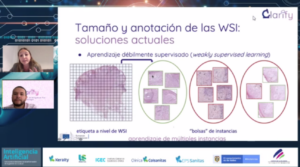Months are flying by in CLARIFY and I am happy I got the opportunity to meet in person 5 of the 11 other ESRs!
Months are flying by in CLARIFY and I am happy I got the opportunity to meet in person 5 of the 11 other ESRs. Hopefully we will soon be able to meet the whole team!
In the last few months, I have completed the development of a deep learning framework that allows using both annotated and unannotated data samples to train the models. To do so, this method combines semi-supervised learning – more precisely self-training – and weakly-supervised learning to leverage available data samples that are often scarce in medical image analysis. Inspired by how expert pathologists analyze daily sign-outs of biopsies, this approach first identifies the coarse region of interest within a whole slide image before extracting patches at a higher magnification level, in an on-the-fly manner.
I am currently in the process of writing a conference paper presenting that approach, collaborating with Andrés (ESR12) on the pathology aspect, that is to say, mimicking pathologists’ analysis process. In parallel, I am also still running a few experiments extracting patches at different magnification levels (i.e. 10x, 20x).
Additionally, in December 2021 I started a new on-site secondment at the Universiteit van Amsterdam, where ESR1 and ESR2 are doing their PhD under the supervision of Dr. Zhiming Zhao. Since then, I have had the opportunity to learn more about cloud-based algorithms and more precisely federated learning, a method that enables multiple institutions to collaborate in the training of deep learning models without having to share their data. I will give more details regarding that secondment in the next blog post!
Last but not least, Andrés (ESR12) and I recently started a systematic review about melanocytic lesions’ analysis by means of artificial intelligence, and are currently selecting the papers that will be used in it.

Figure 1. Virtual conference that Andrés (ESR12) and I gave together at the beginning of November regarding the challenges of automatic WSI analysis from the perspective of both a pathologist and an AI engineer
Laëtitia – ESR7.

